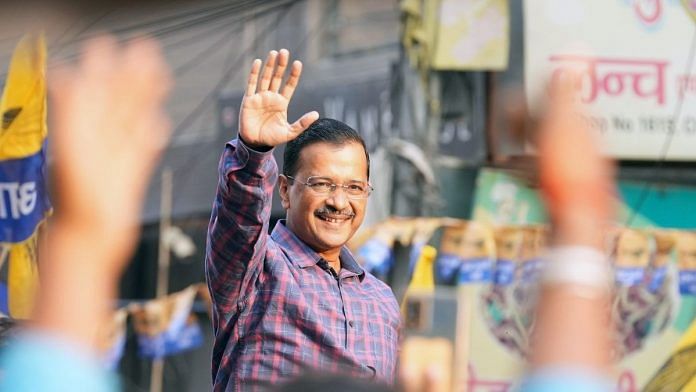New Delhi: The Election Commission (EC) Monday granted the Aam Aadmi Party (AAP) ‘national party’ status, while stripping the Trinamool Congress (TMC), the Nationalist Congress Party (NCP), and the Communist Party of India (CPI) of the coveted tag.
The total number of national parties now stands at six. These include the Congress, the Bharatiya Janata Party (BJP), the Bahujan Samaj Party (BSP), Communist Party of India (Marxist), the National People’s Party (NPP), and now AAP.
Meanwhile, Telangana Chief Minister K. Chandrashekar Rao’s Bharat Rashtra Samithi, earlier known as the ‘Telangana Rashtra Samithi’, has lost its ‘state party’ status in Andhra Pradesh.
The top poll body said Monday that AAP became a state party in Gujarat after its performance in the state’s assembly elections last year. The Arvind Kejriwal-led outfit secured 12.92 per cent of the vote share and won five seats. As a result, the AAP became a state party in four states — Delhi, Punjab, Goa, and Gujarat — thus fulfilling one of the eligibility criteria for national party status under paragraph 6B (iii) of the Symbols Order, stated the EC order issued Monday.
Mamata Banerjee’s TMC on the other hand ceased to be a national party as a result of losing its state party status in Manipur and Arunachal Pradesh, according to the EC order. In Arunachal, the TMC has “not fulfilled the criteria of recognition at the general elections to the Lok Sabha and also to the legislative assembly held during 2014 and 2019”.
TMC still has state party status in Tripura, apart from Bengal.
Similarly in Manipur, the TMC “has not fulfilled criteria of recognition at the general elections to Lok Sabha held in 2014 & 2019 and to the legislative assembly of Manipur held in 2017 & 2022”.
Meanwhile, Sharad Pawar’s NCP, first recognised as a national party in January 2000, held ‘state party’ status in the states of Arunachal Pradesh, Maharashtra, Meghalaya, Manipur and Nagaland. After a review, the EC found that the NCP no longer satisfies the conditions in Meghalaya, Manipur and Arunachal. However, the NCP is still recognised as a state party in Nagaland and Maharashtra.
The CPI — recognised as a national party in 1989 — has also lost its status. It was formerly recognised as a state party in Kerala, Manipur, Odisha and West Bengal, but has lost this status in the latter two states, and is thus no longer a national party.
So what criteria are required to be fulfilled to qualify as a national party, and why did such prominent names lose this tag?
Criteria for recognition
According to paragraph 6B of the Election Symbols (Reservation and Allotment) Order, a political party needs to satisfy any one of three conditions to be recognised as a “national party”.
First, it needs to secure at least six per cent vote share in at least four states during the last Lok Sabha polls or assembly elections. In addition, no less than four Lok Sabha MPs should be elected “at the last general election” from any state or states.
Second, a party satisfies the recognition criteria if it gets at least two per cent of the total seats in the last Lok Sabha election and the elected members come from at least three different states.
Third, as in the case of AAP, the party is recognised as a ‘state party’ in at least four states.
Paragraph 6A of the Symbols Order deals with the ‘state party’ symbol to political parties. A party can be recognised as a ‘state party’, only if it satisfies any of the below five conditions.
First, in the last assembly elections, the party needs to have secured at least six per cent vote share and two MLAs. Second, during the last Lok Sabha polls, the party candidates need to have secured at least six per cent vote share in the state along with election of one Lok Sabha MP.
Third, the party gets recognised as a ‘state party’ if it is represented by three per cent of the total MLAs in the house or at least three seats in assembly, whichever is more. Fourth, if the party has “one member to the House of the People for every 25 members or any fraction thereof allowed to that state”. The last criteria to be recognised by the EC is, for a party’s candidates to secure at least eight per cent vote share in the state assembly elections or in the last Lok Sabha polls from the state.
How other parties fared & fate of KCR’s BRS
There are several other parties whose status has been altered.
KCR’s BRS, when it was TRS, was recognised as a ‘state party’ in undivided Andhra Pradesh. However, after the bifurcation of the state into Telangana and Andhra in 2014, the party did not contest 2014 & 2019 Lok Sabha and assembly polls from Andhra Pradesh. Considering this, the EC now recognises the party as a ‘state party’ only in Telangana.
TIPRA Motha, Voice of the People Party and the Lok Janshakti Party (Ram Vilas) have been recognised as state parties in the states of Tripura, Meghalaya and Nagaland respectively.
On the other hand, the Pattali Makkal Katchi in Puducherry, the Rashtriya Lok Dal in Uttar Pradesh, the Revolutionary Socialist Party in West Bengal, the People’s Democratic Alliance in Manipur, and the Mizoram People’s Conference in Mizoram, have all lost their state party status.
(Edited by Gitanjali Das)
Also Read: AAP, TMC’s national ambitions ignore India’s stark diversity. Southern parties know better



